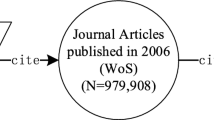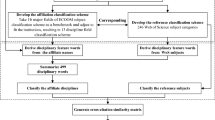Abstract
In this work, the authors propose a definition of book publishers’ specialization-multidisciplinarity and apply the operative definition to a set of 1952 Spanish publishers in 16 fields of the Social Sciences and the Humanities. The definition of specialization-multidisciplinarity is made operative with an entropy-based indicator. The indicator was applied to a set of Spanish scholarly publishers. It was hypothesized that University Presses (UPs hereafter) were significantly more multidisciplinary (or less specialized) than the rest of the publishers according to the values of the indicator. Chi square tests show that the proportion of UPs among the most multidisciplinary publishers is significantly greater than randomly expected. For the settings of this study the hypothesis is confirmed with a p value < 0.01. At the level of discipline, the concentration of titles was studied using Gini Coefficient, finding differences between disciplines within the range of 0.5. The specific features of university presses are discussed as possible explanations for the observed differences in thematic specialization.


Similar content being viewed by others
References
AAUP. (2017). Association of American University Presses. About University presses. Online resource available at: http://www.aaupnet.org/about-aaup/about-university-presses.
Adams, J., & Testa, J. (2011). Thomson Reuters book citation index. In The 13th conference of the international society for scientometrics and informetrics (Vol. 1, pp. 13–18).
AEUP. Association of European University Presses. (2007). The need for AEUP. Online resource available at: http://www.aeup.eu/aeup/about/the-need-for-aeup/.
ANECA. (2008). Principios y orientaciones para la aplicación de los criterios de evaluación, http://www.aneca.es/content/download/10527/118089/version/1/file/academia_14_ppiosyorientaciones.pdf.
Carpenter, M. P. (1979). Similarity of Pratt’s measures of class concentration to the Gini index. Journal of the American Society for Information Science, 30(2), 108–110.
Chavarro, D., Tang, P., & Rafols, I. (2014). Interdisciplinarity and research on local issues: Evidence from a developing country. Research Evaluation, 23(3), 195–209.
Chi, P. S. (2016). Differing disciplinary citation concentration patterns of book and journal literature? Journal of Informetrics, 10(3), 814–829.
Croyle, R. T. (2008). The National Cancer Institute’s transdisciplinary centers initiatives and the need for building a science of team science. American Journal of Preventive Medicine, 35, S90–S93.
DILVE. (2017). Online resource available at: https://www.dilve.es/dilve/dilveweb/index_dilve.jsp.
Elsevier. (2013). Elsevier Announces its Scopus Books Titles Expansion program. Available at: https://www.elsevier.com/about/press-releases/science-and-technology/elsevier-announces-its-scopus-book-titles-expansion-program.
Engels, T. C. E., Ossenblok, T. L. B., & Spruyt, E. H. J. (2012). Changing publication patterns in the social sciences and humanities, 2000–2009. Scientometrics, 93, 373–390.
Giménez-Toledo. (2017). La edición académica española. Indicadores y características. Report available at: http://ilia.cchs.csic.es/SPI/spi-fgee/docs/EAEV1.pdf.
Giménez-Toledo, E., Mañana-Rodríguez, J., Engels, T. C., Ingwersen, P., Pölönen, J., Sivertsen, G., et al. (2016). Taking scholarly books into account: Current developments in five European countries. Scientometrics, 107(2), 685–699.
Giménez-Toledo, E., Tejada-Artigas, C., & Mañana-Rodríguez, J. (2012). Evaluation of scientific books’ publishers in social sciences and humanities: Results of a survey. Research Evaluation, 22(1), 64–77.
Gini, C. (1912). Variabilità e Mutuabilità. Contributo allo Studio delle Distribuzioni e delle Relazioni Statistiche. Bologna: C. Cuppini.
Gorraiz, J., Purnell, P. J., & Glänzel, W. (2013). Opportunities for and limitations of the book citation index. Journal of the American Society for Information Science and Technology, 64(7), 1388–1398.
Hall, K. L., Stokols, D., Moser, R. P., Taylor, B. K., Thornquist, M. D., & Nebeling, L. C. (2008). The collaboration readiness of transdisciplinary research teams and centers. American Journal of Preventive Medicine, 35, S161–S172.
Karlovčec, M., & Mladenić, D. (2015). Interdisciplinarity of scientific fields and its evolution based on graph of project collaboration and co-authoring. Scientometrics, 102(1), 433–454.
Kousha, K., & Thelwall, M. (2015). Web indicators for research evaluation, part 3: Books and non-standard outputs. El Profesional de la Información, 24(6), 724–736.
Kousha, K., Thelwall, M., & Rezaie, S. (2011). Assessing the citation impact of books: The role of Google Books, Google Scholar, and Scopus. Journal of the American Society for Information Science and Technology, 62(11), 2147–2164.
Leydesdorff, L. (2007). Betweenness centrality as an indicator of the interdisciplinarity of scientific journals. Journal of the American Society for Information Science and Technology, 58(9), 1303–1309.
Leydesdorff, L., & Felt, U. (2012). “Books” and “book chapters” in the book citation index (BKCI) and science citation index (SCI, SoSCI, A&HCI). Proceedings of the Association for Information Science and Technology, 49(1), 1–7.
Leydesdorff, L., & Rafols, I. (2011). Indicators of the interdisciplinarity of journals: Diversity, centrality, and citations. Journal of Informetrics, 5(1), 87–100.
Lockett, A., & Speicher, L. (2016). New university presses in the UK: Accessing a mission. Learned Publishing, 29(S1), 320–329.
Mañana-Rodríguez, J. (2017). Disciplinarity and interdisciplinarity in citation and reference dimensions: Knowledge importation and exportation taxonomy of journals. Scientometrics, 110(2), 617–642.
Metz, Paul, & Stemmer, John. (1996). A reputational study of academic publishers. College and Research Libraries, 57(3), 234–247. https://doi.org/10.5860/crl_57_03_234.
Michavila, F. (dir.). (2012). La Universidad española en cifras. Madrid: CRUE, http://www.crue.org/.Publicaciones/Documents/UEC/LA_UNIVERSIDAD_ESPANOLA_EN_CIFRAS.pdf.
Mugabushaka, A. M., Kyriakou, A., & Papazoglou, T. (2016). Bibliometric indicators of interdisciplinarity: The potential of the Leinster–Cobbold diversity indices to study disciplinary diversity. Scientometrics, 107(2), 593–607.
Parsons, P. (1990). Specialization by university presses. Publishing Research Quarterly, 6(2), 3–15.
Porter, A. L., & Chubin, D. E. (1985). An indicator of cross-disciplinary research. Scientometrics, 8, 161–176.
Porter, A. L., Cohen, A. S., Roessner, J. D., & Perreault, M. (2007). Measuring researcher interdisciplinarity. Scientometrics, 72(1), 117–147.
Puuska, H.-M. (2014). Scholarly Publishing Patterns in Finland: A comparison of disciplinary groups. Tampere: Tampere University Press.
Rafols, I., Leydesdorff, L., O’Hare, A., Nightingale, P., & Stirling, A. (2012). How journal rankings can suppress interdisciplinary research: A comparison between innovation studies and business & management. Research Policy, 41(7), 1262–1282.
Rafols, I., & Meyer, M. (2010). Diversity and network coherence as indicators of interdisciplinarity: Case studies in bionanoscience. Scientometrics, 82(2), 263–287.
Shaw, A. (2016). Vision, mission, passion, and luck: The creation of a university press. Learned Publishing, 29(S1), 354–359.
Sivertsen, G., & Larsen, B. (2012). Comprehensive bibliographic coverage of the social sciences and humanities in a citation index: An empirical analysis of the potential. Scientometrics, 91(2), 567–575.
Steele, C. (2008). Scholarly monograph publishing in the 21st century: The future more than ever should be an open book. JEP: The Journal of Electronic Publishing. https://doi.org/10.3998/3336451.0011.201.
Stegmann, J., & Grohmann, G. (2001). Citation rates, knowledge export and international visibility of dermatology journals listed and not listed in the Journal Citation Reports. Scientometrics, 50(3), 483–502.
Stirling, A. (2007). A general framework for analysing diversity in science, technology and society. Journal of the Royal Society, Interface, 4(15), 707–719.
Thompson, J. B. (2005). Books in the digital age: The transformation of academic and higher education publishing in Britain and the United States. Cambridge: Polity Press.
Tomov, D. T., & Mutafov, H. G. (1996). Comparative indicators of interdisciplinarity in modern science. Scientometrics, 37, 267–278.
Torres-Salinas, D., Robinson-Garcia, N., Miguel Campanario, J., & Delgado Lopez-Cozar, E. (2014). Coverage, field specialisation and the impact of scientific publishers indexed in the Book Citation Index. Online Information Review, 38(1), 24–42.
Uddin, S., Khan, A., & Baur, L. A. (2015). A Framework to explore the knowledge structure of interdisciplinary research fields. PLoS ONE, 10(4), e0123537.
UNE. (2014). Interview with Rafael Van Grieken, head of ANECA. Available at: http://www.une.es/media/Ou1/Image/webmayo2014/UNElibros%2028%20DIG.pdf.
Verleysen, F. (2016). Books in the social sciences and humanities: analyses of scholarly publication patterns in Flanders based on the VABB-SHW (Doctoral dissertation, University of Antwerp).
Verleysen, F. T., & Engels, T. C. E. (2013). A label for peer-reviewed books. Journal of the American Society for Information Science and Technology, 64, 428–430.
Vugteveen, P., Lenders, R., & Van den Besselaar, P. (2014). The dynamics of interdisciplinary research fields: The case of river research. Scientometrics, 100(1), 73–96.
Wagner, C. S., Roessner, J. D., Bobb, K., Klein, J. T., Boyack, K. W., Keyton, J., et al. (2011). Approaches to understanding and measuring interdisciplinary scientific research (IDR): A review of the literature. Journal of Informetrics, 5(1), 14–26.
Zuccala, A., Guns, R., Cornacchia, R., & Bod, R. (2014). Can we Rank scholarly book publishers? A bibliometric experiment with the field of history. Journal of the American Society for Information Science and Technology, 66(7), 1333–1347.
Zuccala, A. A., Verleysen, F. T., Cornacchia, R., & Engels, T. C. (2015). Altmetrics for the humanities: Comparing Goodreads reader ratings with citations to history books. Aslib Journal of Information Management, 67(3), 320–336.
Acknowledgements
Funding was provided by Consejo Superior de Investigaciones Científicas (Grant No. CSO2015-63693-P).
Author information
Authors and Affiliations
Corresponding author
Appendix 1
Appendix 1
See Table 4.
Rights and permissions
About this article
Cite this article
Mannana-Rodriguez, J., Giménez-Toledo, E. Specialization and multidisciplinarity of scholarly book publishers: differences between Spanish University Presses and other scholarly publishers. Scientometrics 114, 19–30 (2018). https://doi.org/10.1007/s11192-017-2563-z
Received:
Published:
Issue Date:
DOI: https://doi.org/10.1007/s11192-017-2563-z




